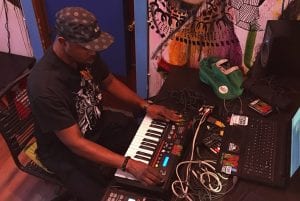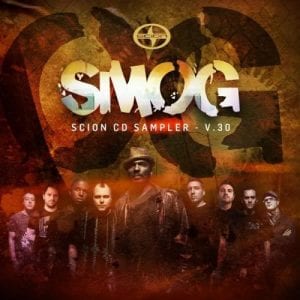In today’s world of music, there are so many artists it is far too easy to miss the plethora of great art out there. What we seek out is different for everyone, but one element that always stands out is when an artist’s unbridled passion. Kemst is one of those artists; one who has deftly brought together the style of the streets and fused that with the surrealism present in beat music.
First came the creation of the name. “Originally, it wasn’t even a name for music,” he explains. “It was for graffiti and at the time, I wanted a different name. I had a few and was switching up and switching schools so I was like, I want a name. I was watching a bunch of stuff and saw Ghostbusters…. heard Keymaster and was like, ‘Whoa, that’s fresh’. After that, I realized that’s a lot to write and tag up and so I shortened that to Kemst. I had a few names to rhyme under since I was doing some hip-hop stuff but being creative I didn’t come up with another name and everyone was calling me Kemst, that’s who I was so I switch up.”
Next came the long journey into the world of music. “There was a piano in my house when I was a kid,” Kemst explains. “My sister could play, and I kind of wanted to play…. but I was doing other things so I wasn’t into it in that way. A year or so later, having been touched by hip hop as a younger kid, seeing cousins with turntables and everything, it stayed in my brain. Later, some friends of mine were getting really into it and I thought, ‘Yea, I’m down with that’.
“I saved up money from allowances and got some belt drive turntables. Started playing events like my sister’s engagement party, house gigs, birthday parties and whatever so I was able to upgrade to a full sound system, though not by our current standards of a sound system. That was the first time I was trying to make it and got the first consumer sampler keyboard. I would sample the b-side of Public Enemy’s “Black Steel In The Hour Of Chaos”, which was “B-side Wins Again.” So, I’d get that and you had to tape the key down so it plays the sample…and you have to get the loop and it’s a real short sample time, you either got it or you don’t. I never could record the full thing cuz people would always open the bedroom door or something like that.”
The early nineties were a wild and diverse time to be into music; electronic music was first starting to make its presence known, while we still had the weirdness of rock as a dominant force along with hip-hop beginning to take over. Kemst took full advantage and dabbled in pretty much everything.
“I was DJing for a while, just doing that and wasn’t rapping or anything like that,” he elaborates. “About ‘93-’94, I got into a couple bands: one was a hardcore band I did cameos with called Hateface; and I used to get up and spit freestyles with one called LA Downset, like 90’s era hardcore style and my graffiti crews were in it as well. I was also in an acid jazz band called Indigenous Colors for a couple years, and we did record some stuff. There was one EP we recorded but it was never released. Actually, I got with them because I got on the mic at a party and afterwards the guitarist hit me up. It’s funny cuz everyone in that band had timing and desire – the trumpet player went to DaKah the hip hop orchestra; the sax player was with Ozomatli – everyone was doing something …. I don’t know if it was just luck or timing.”
Jungle music started coming into the LA scene around this time and grabbed hold of him like nothing else. “Then I was a cajoled by a friend to go to his house, to hang out with his friend who I went to high school with, but we didn’t really hang out back then,” recounts Kemst. “And that guy was Deacon, to hear his mixtapes and just know the strength of this DJ…. R.A.W., Deacon, and Machete – that was the row going down. Curious on top too, those were the local original rude boy crews you know? THAT was recognition. Before that, it was the pressure crews, and that had Markman who now does Markman Sound. He now teaches at SAE and at the Musician’s Institute and is just a heavy sound design and Ableton cat.
“A lot of people were just doing things because the Internet didn’t exist in its current form and so you had to really seek it out. It was still the era of, ‘I don’t know if your cool enough to have this tape’. After that, I was still making music, but it seemed like everyone was collecting the best of drum and bass because all of it was coming out on vinyl and there were ten records per city. So, if you were buying it, you were getting the most out of date stuff in the world because the timeline of a tune was that fast. It was really quick and that didn’t really interest me, I was like ‘I’ll never keep up’.”
From the get go, he sought to differentiate himself and found highly creative ways of doing that. “So, I would just buy a lot of old soul, jazz, reggae, and dollar bin hip hop,” says Kemst. “Especially the instrumental sides since nobody listens to these songs. So those instrumentals were fresh when you played it.
“I was making music, but nothing got saved; and now it’s come to, since that time and ever since dubstep manifested…work time and hustle all came together to where you could finally have a computer that recorded what you want. It wasn’t a tower or anything, but I got the stuff…maybe not all the right stuff…. I was working with Cubase at first and got monitors way too big for my space, but that setup led me to reason.”
The rapid technological development became both a blessing and a curse for Kemst. “I was frustrated and was trying to get with the learning curve!” he expounds. “This was ’06-’07 and at the time was coming back from a double hernia surgery, had a bum knee, and thought I was done. I had no diaphragm and couldn’t spin; the year prior had been in the streets for a minute….so I was really finding redemption. That setup, that manifestation and after only a year getting back into it, I’m all of a sudden being quoted as the dubstep guy even though I was still playing drum and bass stuff.
“And as I moved over and was playing these other shows, I always made room for other dudes to get on the mic too; I’ve always been cool with everyone trying to do their thing. We kicked all that around to other people a few times and using Biggie samples until I said ‘Teflon’, which becomes the tune with Kelly Dean and Steady, Orange County dudes.
“It was a wicked tune via Smog Crew, and that reverberating to where Excision and Datsik did their remix. That became the anthem for a while and to a lot of people, as far as the term dubstep goes, and was known as one of the ten greatest dubstep drops.”
The journey is just beginning……stay tuned for part two!!


